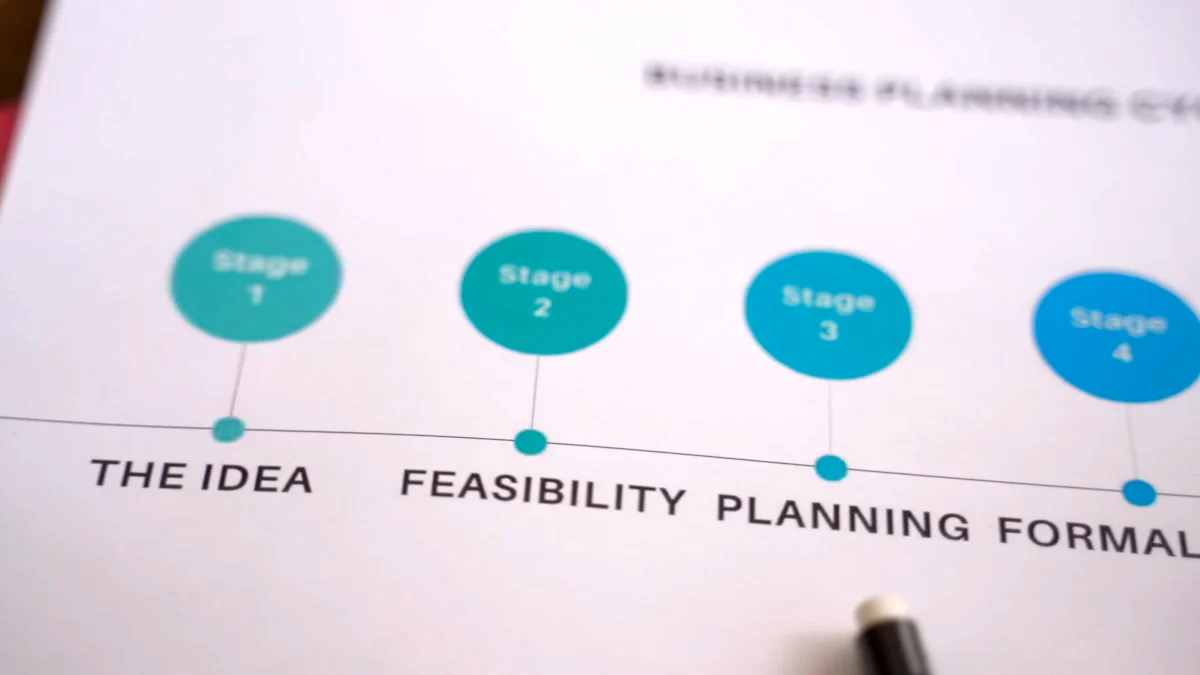


Business Process Modeling creates visual representations of workflows. Organizations use these models to understand and improve processes. A clear view of operations helps identify inefficiencies. Successful models must be usable. This modeling provides a framework for analysis and optimization. Businesses gain insights into their operations. The process encourages employees to take ownership. Business Process Modeling offers a path to streamline operations. Organizations can achieve better communication and collaboration. Understanding these models sets the stage for deeper exploration.
Understanding Business Process Modeling

Definition and Overview of Business Process Modeling
Business Process Modeling (BPM) creates visual representations of business workflows. These models help organizations understand and improve their processes. Businesses use BPM to identify inefficiencies and optimize operations.
Key Concepts
Key concepts in BPM include process mapping and workflow visualization. Process mapping breaks down complex workflows into manageable parts. Workflow visualization offers a clear view of each step in a process. These concepts enable better analysis and optimization.
Historical Context
Taylorism and Fordism played crucial roles in the development of BPM. These early industrial engineering methods focused on efficiency and productivity. The 2000s saw advances in Business Process Management software. This software handles everything from modeling to analytics. Historical innovations laid the groundwork for modern BPM practices.
Components of Business Process Modeling
Understanding BPM requires knowledge of its main components. These components form the foundation of effective process modeling.
Process Mapping
Process mapping involves creating detailed diagrams of workflows. These diagrams illustrate each step in a process. Businesses use process mapping to identify bottlenecks and redundancies. Clear maps lead to more efficient operations.
Modeling Tools and Techniques
Various tools and techniques support BPM. Software applications provide platforms for creating and analyzing models. Techniques like flowcharts and Gantt charts offer visual clarity. These tools and techniques enhance understanding and communication within organizations.
How Business Process Modeling Functions in Organizations
Integration with Business Operations
Business Process Modeling plays a crucial role in integrating with business operations. The modeling process provides a structured approach to understanding workflows. Organizations use this structure to manage and optimize their operations.
Workflow Management
Workflow management involves organizing and controlling the flow of tasks. Business Process Modeling helps organizations visualize these workflows. Clear visualizations allow managers to identify bottlenecks. Managers can then make informed decisions to improve efficiency. This process leads to more streamlined operations.
Automation and Efficiency
Automation becomes achievable through effective Business Process Modeling. By laying the groundwork for automation, businesses increase productivity. The modeling process identifies repetitive tasks suitable for automation. Automation reduces manual intervention and increases efficiency. Businesses experience enhanced scalability as a result.
Role in Strategic Planning
Business Process Modeling supports strategic planning within organizations. The modeling process aligns business processes with organizational goals. This alignment ensures that operations contribute to strategic objectives.
Aligning Processes with Goals
Aligning processes with goals requires a clear understanding of workflows. Business Process Modeling provides this understanding. Organizations use models to ensure that each process supports overall goals. This alignment leads to more focused and effective operations.
Risk Management
Risk management benefits from Business Process Modeling. The modeling process identifies potential risks within workflows. Organizations can then develop strategies to mitigate these risks. Effective risk management ensures smoother operations and reduces disruptions.
Importance of Business Process Modeling
Streamlining Operations
Business Process Modeling enhances your ability to streamline operations. Visual models help you identify inefficiencies. You can pinpoint areas where processes overlap or become redundant.
Reducing Redundancies
Redundancies waste resources and time. Business Process Modeling allows you to map workflows clearly. This clarity helps you spot unnecessary steps. Eliminating these steps reduces costs and improves efficiency.
Enhancing Productivity
Productivity increases when processes run smoothly. Business Process Modeling provides a framework for continuous improvement. You can adapt processes to meet changing needs. This adaptability leads to greater agility and scalability.
Improving Communication
Effective communication is crucial in any organization. Business Process Modeling fosters better understanding among team members. Clear visualizations make complex processes easier to grasp.
Facilitating Collaboration
Collaboration thrives when everyone understands their roles. Business Process Modeling creates a shared language for teams. This common understanding encourages teamwork and innovation.
Clearer Process Understanding
Understanding processes is key to success. Business Process Modeling offers a visual representation of workflows. These visuals help you and your team grasp each step. A clear view of processes leads to informed decision-making.
Supporting Continuous Improvement of Business Process Modeling
Feedback and Adaptation of Business Process Modeling
Businesses should track key performance indicators. These metrics provide valuable insights into process efficiency.
Monitoring and Evaluation
Monitoring involves observing workflows in real-time. Businesses can use software tools to track progress. Evaluation assesses the outcomes of these processes. Organizations should compare results against set goals. This comparison highlights areas needing adjustment. Continuous evaluation ensures that processes align with business objectives.
Iterative Process Enhancement
Iterative enhancement focuses on making gradual improvements. Businesses should implement changes based on feedback. Small adjustments can lead to significant gains. Organizations should encourage employees to suggest improvements. This approach fosters a culture of continuous improvement. Iterative enhancements increase productivity and agility.
Innovation and Growth of Business Process Modeling
Innovation drives the growth of Business Process Modeling. Organizations must embrace new ideas and technologies. Creativity leads to novel solutions for process challenges. Businesses should create environments that encourage experimentation. This openness to innovation supports long-term success.
Encouraging Creativity
Creativity fuels the evolution of Business Process Modeling. Organizations should promote creative thinking among employees. Brainstorming sessions can generate fresh ideas. Businesses should reward innovative solutions. Encouraging creativity leads to more effective process models.
Adapting to Market Changes
Market dynamics constantly evolve. Businesses must adapt their processes to remain competitive. Business Process Modeling provides the flexibility needed for adaptation. Organizations should monitor market trends closely. This awareness allows for timely adjustments to processes. Adapting to changes ensures sustained growth and cost reduction.
Challenges and Considerations in Business Process Modeling
Common Obstacles of Business Process Modeling
Resistance to Change
Organizations often face resistance when implementing Business Process Modeling. Employees may feel uncertain about new methods. Familiar routines provide comfort. Change disrupts this comfort. Leaders must communicate the benefits clearly. Highlighting improvements can ease fears. Encouraging participation fosters acceptance. Employees who understand the value become advocates.
Complexity of Implementation
Implementing Business Process Modeling involves complexity. Organizations must manage multiple components. Tools and techniques require careful selection. Clear goals guide the process. Without clear goals, confusion arises. Training ensures everyone understands their roles. Consistent support helps overcome challenges. A structured approach simplifies implementation.
Best Practices of Business Process Modeling
Engaging Stakeholders
Engaging stakeholders is crucial for success. Stakeholders provide valuable insights. Involving them early builds commitment. Open communication encourages collaboration. Regular updates keep everyone informed. Feedback from stakeholders enhances models. Successful engagement leads to effective processes.
Continuous Training
Continuous training supports Business Process Modeling. Training keeps skills up-to-date. New tools and techniques emerge regularly. Employees must adapt to changes. Ongoing education ensures readiness. Workshops and seminars provide learning opportunities. A well-trained team drives successful implementation.
"A business is only as efficient as its processes. A business process model is only as successful as its implementation."
George Box, a renowned statistician, reminds us:
"All models are wrong, some models are useful."
Understanding these insights helps navigate challenges. Effective Business Process Modeling requires thoughtful consideration. Implementing best practices leads to meaningful improvements.
Future Trends in Business Process Modeling

Technological Advancements
AI and Machine Learning
AI and Machine Learning transform Business Process Modeling. These technologies analyze vast amounts of data quickly. Businesses use AI to predict trends and optimize workflows. Machine Learning adapts processes based on real-time information. This adaptability leads to smarter decision-making. Companies gain a competitive edge by implementing these tools.
Cloud-Based Solutions
Cloud-based solutions offer flexibility in Business Process Modeling. Businesses access models from anywhere using cloud technology. This accessibility enhances collaboration among teams. Cloud platforms provide scalable resources for growing needs. Companies reduce costs by eliminating physical infrastructure. Security features ensure data protection and compliance.
Evolving Business Needs
Globalization
Globalization impacts Business Process Modeling significantly. Businesses operate in diverse markets with varying regulations. Models must adapt to different cultural and legal requirements. Companies streamline operations across borders through effective modeling. Globalization demands agility and responsiveness in process management.
Sustainability
Sustainability becomes a priority in Business Process Modeling. Businesses focus on reducing environmental impact. Models incorporate eco-friendly practices and resource efficiency. Companies align processes with sustainability goals. This alignment enhances brand reputation and customer loyalty. Sustainable practices lead to long-term success and cost savings.
Business Process Modeling plays a vital role in modern business practices. Businesses use this tool to optimize operations and prepare for scalability. The modeling process identifies the best ways to perform tasks. Organizations that adopt this approach often see success. Business Process Modeling encourages efficiency and clarity. Companies that implement these models find improved communication and collaboration. Embracing this method leads to streamlined processes and better decision-making. Organizations should consider adopting Business Process Modeling for long-term success.
FAQ
Business Process Modeling creates visual diagrams of workflows. Organizations use these diagrams to understand and improve processes. Visual models help identify inefficiencies and optimize operations.
Business Process Modeling streamlines operations and enhances communication. Models provide clarity and facilitate collaboration among team members. Organizations achieve better efficiency and productivity through improved processes.
Various tools support Business Process Modeling. Software applications like flowchart creators and Gantt chart tools offer visual clarity. These tools help organizations create and analyze process models effectively.
Resistance to change often poses a challenge. Employees may feel uncertain about new methods. Complexity in implementation requires careful planning and training. Clear goals and consistent support help overcome these challenges.
Feedback and adaptation play crucial roles. Organizations gather input from employees and stakeholders. Regular monitoring and evaluation ensure processes remain efficient. Iterative enhancements lead to ongoing improvements.
Technological advancements like AI and Machine Learning transform modeling. Cloud-based solutions offer flexibility and accessibility. Evolving business needs demand adaptability to globalization and sustainability.
Continue Reading About Business Process Modeling
Which Data Analysis Projects Work Best for Beginners?
Ready to shine in 2025? Discover easy data analysis projects to boost your portfolio, learn data cleaning, visualization, and tackle real-world challenges!
Lewis
Mar 10, 2025
Data Analysis vs Data Analytics: What’s the Real Difference?
Data Analysis vs Data Analytics: What’s the Difference? Discover How One Interprets History While the Other Shapes Tomorrow. Explore Here!
Lewis
Mar 10, 2025
Empower Your Business: Best Financial Reporting Tools 2025
Discover the best financial reporting tools in 2025 for streamlined processes and accurate insights. Empower your business with advanced solutions!
Lewis
Jun 15, 2024


